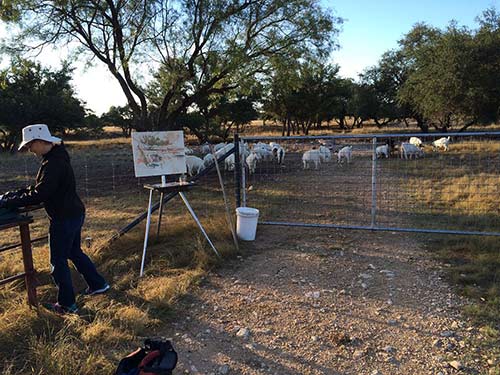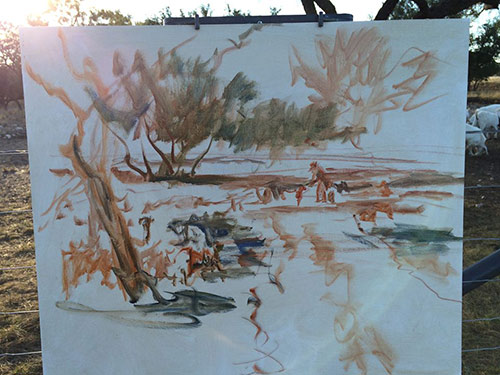Many artists were surprised to find that Mary Pettis’s award-winning painting of goats was done en plein air. It’s natural to think the setting was painted on location and the goats added later from reference. Nope.
Lead Image: “Breakfast at Treva’s,” by Mary Pettis, 2015, oil on linen, 20 x 24 in. Third Place at EnPleinAir TEXAS 2015.
Like many strong paintings, Pettis’s painting “Breakfast at Treva’s” was planned in advance. “I knew ahead of time the basic components would be in order,” she says. “The weather was perfect; Treva, the co-chair of the event, had goats she would be feeding near the gate shortly after sunrise; and I could be behind the gate.”
The artist reports that the idea for the painting came quickly, and the execution played out over more than four hours. “When I saw the road into the pasture, the angle of the light on the herd, and the lovely character of a handful of individuals, the completed painting truly flashed across my mind,” says Pettis. “I love when that happens. It feels like it’s all composed, and all I have to do is show up! I did some quick (about two minutes) gesture and placement notes to myself on the canvas while Treva was still out there. Then I chose my color palette.

“Treva left me with some feed so I could keep the goats interested in staying around. I asked her to return in a couple of hours so I could paint her in more accurately. I painted thin washes of the main components — the armature of the trees on the horizon and the separation of light and shadow in the scene. I knew I would nail the light effect down in about an hour, so I kept the drawing fluid until I had defined the shape of the groupings of goats. I first saw them as a larger, heavier mass on the left that connected to smaller, geometric groups going back in space, visually leading to Treva, then beyond. Each mass had a top plane, front plane, and side plane.

“People ask me, how did I paint the moving goats? Well, I knew where I wanted the main characters, and when one appeared in the right spot, I painted her in. I painted them one at a time, and if she’d move, I would paint someone or something else until she lifted her head or stepped back into position. I squinted down and tried to see the subjects in as few strokes as possible. That is my greatest challenge as a painter, and as a lover of too many details. My solution for this weakness was to do much of the detail by cutting in the background colors to define a few of my favorite actors. In a complicated scene such as this, there is no time to refine edges or bring out the small brush. I wanted to keep the sense that they are moving, breathing fellow creatures bathed in the same happy light I was in.”





You did a beautiful job of simplifying in order to capture your subject matter.
Where are you and do you teach?